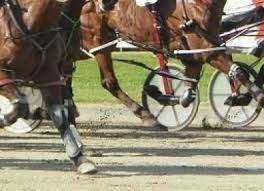Lexington, Kentucky’s Red Mile is enjoying a sizzling summer harness racing meeting these days with handle more than double over the previous year’s summer meet.
There are a number of reasons for this, according to Red Mile spokesman Gabe Prewitt, including the quality of horseflesh on the Red Mile grounds, the great trainers and the gents in the sulkies behind them, the all-important placing of post times avoiding conflicts with other tracks racing and the new “breakage” law in place which puts more money in the bettor’s pocket.
horseflesh on the Red Mile grounds, the great trainers and the gents in the sulkies behind them, the all-important placing of post times avoiding conflicts with other tracks racing and the new “breakage” law in place which puts more money in the bettor’s pocket.
“Our handle has blossomed this season and has also been positively affected by the guaranteed pools on some of our exotic wagering events,” said Prewitt, “just as they helped boost the handle at Pompano Park.
“Kentucky is exploding with talent,” said Prewitt. “A 1:50 mile these days is becoming a regular occurrence with final quarters approaching a thoroughbred’s time. It’s really remarkable!”
In a State where the “horse” is a very important part of the agriculture industry, it’s too bad that some other States like Florida or Illinois or Michigan don’t see the importance of the equine industry and give the horse the attention it deserves.
In Florida, where horsemen rallied throughout the county back in 2004 drumming up votes for the construction of a casino, based on the promise that pari-mutuel racing would survive and thrive, when push came to shove, voters were ignored by Florida’s Governor and the decoupling bill was signed destroying many thousands of lives and families.
Kinda proves political money is much stronger than any contract with the voters!

Of course, greed plays a big role in the gaming industry with State lotteries, casinos and sports betting all vying for the gambling dollar with racing a liability these days because of the cost of operating a racetrack.
Amazing that the argument that spending $15,000,000 a season on racing to make $150,000,000 a year in the casino is not enough, especially when land is worth $2 million an acre.
The Red Mile is a rare example of successful racing and fingers are crossed that tracks with handle that can’t sustain racing on its own will survive in the future as needs grow in other areas deemed more important.
One horseman put it best when saying, “You can’t cut purses or offer shoestring purses. Those involved have a ton of money invested from the day of foaling forever.
“Top notch training and care costs a lot of money and one can’t get the investment back if you race for $2,700, especially when sawdust is $1,500 or $1,800 a pile…just one simple example.
“It kind of reminds me of the story where an owner was searching for a trainer up in mushroom land—Pennsylvania.
“The price was $2,000 a month plus manure rights!
“When the guy continued shopping for a trainer, he found one for $600.
“The owner asked, ‘Plus manure rights, I assume?’”
“The trainer laughed at him and said, ‘for $600, ain’t gonna be no manure!’”
While that may seem funny to some, it’s a huge deterrent for investment in the equine industry.
But back to the Red Mile…purses for their last three Sunday, Monday, Tuesday days, were close to $1.000,000—without a single one over $80,000!
Not only have many owners benefitted from the Red Mile meeting this summer, the bettors, too, have, as well.
When Kentucky Representative Adam Koenig got the Blue Grass legislators to reduce the “breakage” at the track from the typical nine cents to one cent, little did anyone realize what a positive affect it would on the pari-mutuel wagering in his State.
For example, on Tuesday (August 23) at The Red Mile, Blue Bayou Deo, with John MacDonald in the bike, won at tote board odds of 1:9.
At any other track than the Red Mile, the mutuel would have been $2.20—a 10% profit on any wager to win. But, over at 1200 Red Mile Road, the mutuel was $2.38 because the breakage was just a minute fraction under the 2.20 threshold.
Now that might mean too much to the $2 bettor getting $2.38, but it’s $18 more for the punter who bet $200. In fact, it almost doubled his profit! And that $18 just might have gone back in the mutuel machines.
Also, that day, Unleashed Kemp, handled by Andrew McCarthy won at odds of 5 to 1—that mutuel being $13.98—instead of $13.80.
One more example is Top Rank, driven by Christian Lind.
Off at exact breakage odds of $4.99 to 1, the win payoff was $11.98, instead of $11.80—or the 9 to 2 tote board price of $11.00.
Still seem trivial?
Over those three days of racing at the Red Mile, it is estimated that $55,800 extra dollars were distributed to winning ticket holders, where those tickets were for win, place, show, exacta, trifecta or daily double and “folks can thank Representative Adam Koenig for that,” said Prewitt.
So, it’s not so trivial anymore!
Maybe this is the reason that many casinos have changed their policy to not give change when players cash out at automated cash machines but, rather, make the player travel to a faraway cashier to cash a change voucher distributed. Many just don’t!
If it amounts to $55,800 at The Red Mile over three days, how much does the casino reap because of the laziness, unwillingness or inability of the gambler to get to a cashier and then wait in line to get 17 cents or 56 cents or 12 cents!!!!!!
I’m betting many could retire with a couple of months’ worth of those vouchers.
by John Berry, for Harnesslink

 USA
USA Canada
Canada Australia
Australia New Zealand
New Zealand Europe
Europe UK / IRE
UK / IRE



